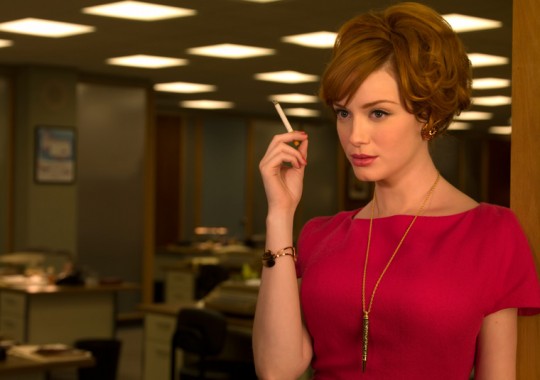There’s an episode in the first season of Mad Men, "Indian Summer," in which the constraints of basic cable are both hinted at and played with by the show’s creative staff.
Early in the episode, Peggy Olson (Elisabeth Moss) is given an assignment: Find out how to market an electric weight loss belt to women. When she tries it out, the prim and proper Peggy realizes that most women won’t be interested in using the belt to drop a few pounds: rather, they’ll enjoy the tingles that the "Electrosizer’s" vibrations inspire. Of course, this being the 1960s, they can’t just come out and say what the primary benefit is. Peggy’s first real test as a writer of advertising copy is to find a way to subtly hint at the belt’s real properties.
"It’s hard to put into words," she says, to which Don Draper (Jon Hamm), with characteristic brusqueness, replies, "Then you have failed." Sighing, she expands. "It vibrates. And that coincides with how you wear it? … That explains its success. And it basically made me think it was probably unrelated to weight loss."
"We now have a benefit," Don replies. "We just have to figure out how to put it into words." Later in the episode, Peggy finds a way to do just that. "The Rejuvenator," as she has rechristened her product, "gives you the flush and glow, not only that you might have after hours of exercise, but certainly as a young girl. Isn’t it nice to feel that way whenever you want?" Her closing line: "The Rejuvenator: You’ll love the way it makes you feel." The pitch is good, but not great. She is suggested to hint more strongly at its "stimulating" properties, to add a "code word—like ‘refreshing.’"
The point, not-so-subtly made by creator Matthew Weiner and his compatriots in the writer’s room, is that working within constraints forces creative types to actually be creative. And one can’t help but think the Sopranos alum is taking a shot at his former network. Imagine how this set of scenes may have played out on HBO or Showtime: Rather than having Peggy try out the product fully clothed and only very briefly, her experience with the machine would have been far more tawdry, far more drawn out. The camera would have lingered on her as she experienced the wide range of pleasures provided by the machine: narrative interruptus, if you will.
Worse than the story’s disruption, though, would’ve been the betrayal of the character herself. Peggy’s immediate rejection of the machine feels right. She is unsure of herself and uncomfortable with her body, stuck halfway between the bright lights of Manhattan and the cozy confines of her churchly upbringing. She’s not the sort of girl would’ve luxuriated in The Rejuvenator’s rejuvenations. On pay cable the temptation to sacrifice the cohesiveness of a character may have been too great to withstand. On AMC, it’s not really a problem.
There is something to be said for forcing oneself into working within a set of standards, even if one doesn’t entirely agree with them. Constraints can be conducive to creativity. In his examination of the life and times of Joseph Breen—the power behind the throne of the Hays Code, Hollywood’s earliest attempt at self-censorship designed to appease local censor boards around the country—Thomas Doherty noted that censoriousness didn’t necessarily coincide with a decline in creativity. Indeed, almost the opposite:
Far from being an impediment, the in-house censorship regime facilitated the artistic creativity and industrial efficiency of the vaunted Golden Age of Hollywood. The Breen Office maintained the gold standard by helping the major studios refine the substance, polish the surface, and corner the market.
Now, the Hays Code was far from perfect. It stifled efforts by Hollywood studios to tell the truth about the scourge of Nazism, for instance. (The Self Styled Siren has more complaints here; for a countering view, see Ed Driscoll.)
However, there is something to be said for forcing subtlety on creators. In an age where anything goes you have less reason to waste time on witty repartee or smart dialogue; flirting devolves into fornicating with stunning ease. I’m not exactly a puritan—Deadwood and The Sopranos, the two best shows of the New Golden Age of Television, are set largely in a brothel and a strip club, respectively—but I’d be lying if I said I thought Mad Men, or The Americans, or The Walking Dead would be better served airing on a station with fewer restraints.
This post was inspired by the following Chris Suellentrop tweet:
Assignment: Argue that HBO would have ruined Mad Men by insisting on lots of graphic sex. Writers: @emilynussbaum @poniewozik @SonnyBunch
— Chris Suellentrop (@suellentrop) March 14, 2014
